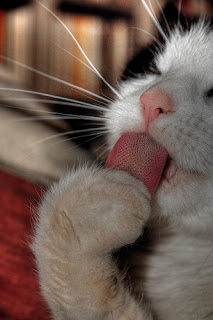Since the small auditorium where the conference took place filled up quickly, the organizers decided to allow the remaining spectators (about 50 of them or more!) to sit in the tiny entrance and listen to the conference while watching it on a TV screen.
This is not an uncommon practice. Still, there was something about it that made one wonder. We could hear the speaker, but the image on the TV screen showed only the images that were projected to accompany the lecture (because of the size of the TV, it wouldn't make sense to get the general view of the stage). Delfim Sardo read his lecture, and although I couldn't see it to confirm it and he is an excellent reader, often stopping to tell an anecdote or two, the bulk of it was there in the text. So there we were, all 50 of us, sitting in a hallway, some of us standing or sitting on the ground, to listen to a lecture and see a series of images.
What was it about the event that made it so unique? Was it because we had all traveled that far and didn't want to leave empty-handed? Or was it because it was free? Or because it was so original? One thing was certain: one can hardly say it was because it was live. The conference could very well be an illusionist trick, there could be no one there and what we would have gotten would have been the same: a recorded voice and recorded images. The 'live' aspect of that event was a pure convention. Yet, nearly no one left in the middle.
There is something in the idea of witnessing that is more powerful than the actual thing.
The conference was mainly about the possibilities of using photography as a means of transforming reality, their origins and their impact. We saw the impressive, huge Russian constructivist images and compositions, and the comparable Nazi posters, and the contemporary works of the likes of Jeff Wall - with the references do Velasquez and Monet... All this on a small TV screen reproducing the reproduction that Delfim Sardo made of a reproduction of a reproduction. And yet, it was the real thing.
Now, see the work of Thomas Wrede, photographer. Thomas Wrede seems to be enjoying the idea that it is still, and yet again, the real thing. It can start off with the pleasure of bringing pieces together to create a certain impression of reality:
Let's go a step further, then:
(But what is the work here - the picture of the snowy landscape or the picture you see above, with the spectators included?)
Finally, let's move out of this tight exhibition room or hall, let's go out.
Oh, how I enjoy this hesitation, this pleasure of falling into the trap, into the work, out of the auditorium where the comfortable presence of the speaker would have made everything transparent and much, much too plain.




































